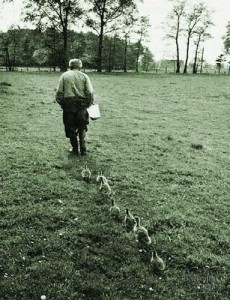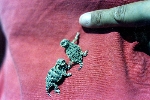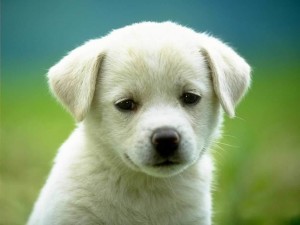 Mascara, eye-liner, and shadow can make the eyes stand out and look much larger than they actually are. Lipstick can make the lips look rounder and puffier. Why do we find this attractive? Properly applied, eye make-up and lipstick will emphasize facial features that make an adult look more like a baby. And we are irresistibly attracted to the faces of babies.
Mascara, eye-liner, and shadow can make the eyes stand out and look much larger than they actually are. Lipstick can make the lips look rounder and puffier. Why do we find this attractive? Properly applied, eye make-up and lipstick will emphasize facial features that make an adult look more like a baby. And we are irresistibly attracted to the faces of babies.
What is it about the way babies look that makes them so cute?
 In addition to those eyes that are extra large compared to the size of their heads, babies’ foreheads are large for their faces, and their heads are large relative to their bodies. They have soft, round, non-angular features. Their cheeks are large and puffy, with no visible cheekbones. Their little hands and fingers, and the joints on their stubby arms and legs, are soft and dimpled.
In addition to those eyes that are extra large compared to the size of their heads, babies’ foreheads are large for their faces, and their heads are large relative to their bodies. They have soft, round, non-angular features. Their cheeks are large and puffy, with no visible cheekbones. Their little hands and fingers, and the joints on their stubby arms and legs, are soft and dimpled.
Reptiles may be born small, but they never look like babies
 This set of features, called babyishness, was studied by the ethologist (animal behaviorist) Konrad Lorenz. The Austrian Nobel Prize winner is perhaps best known for imprinting himself on baby geese, who then followed him around as if he was their mother. Baby ducks and geese want to stay close to the first thing they see that moves (usually it’s their mother).
This set of features, called babyishness, was studied by the ethologist (animal behaviorist) Konrad Lorenz. The Austrian Nobel Prize winner is perhaps best known for imprinting himself on baby geese, who then followed him around as if he was their mother. Baby ducks and geese want to stay close to the first thing they see that moves (usually it’s their mother).
Imprinting is an example of an innate releasing mechanism: actions, colors, patterns that provoke an automatic response. Innate releasing mechanisms set off a behavioral response that helps a species survive. If baby geese didn’t follow their mother, they could be in danger. If parents weren’t irresistibly attracted to their babies, they might not provide the extended nurturing infants need. Babyishness is an innate releasing mechanism.
 Babyish features are found only in animals that are immature when they’re born and that require parenting. Species that are born ready-to-go, so to speak, look like miniatures of their parents from the get-go. Baby lizards, for example, like the horned lizards in the photo, look just like adult lizards, only smaller.
Babyish features are found only in animals that are immature when they’re born and that require parenting. Species that are born ready-to-go, so to speak, look like miniatures of their parents from the get-go. Baby lizards, for example, like the horned lizards in the photo, look just like adult lizards, only smaller.
We don’t know how newborns that need extended parenting developed their babyish features. Presumably the features appeared at some point in evolution and served as a stimulus that released affection and nurturance from adults. Because this has survival value, the traits were then passed on to future generations.
Ooohhh! That’s so cute!
 Responding to that immature, I’m helpless, please-take-care-of-me look is not limited to mothers and their babies. Adolescents, childless adults, men and women can’t resist reacting to the way a baby looks.
Responding to that immature, I’m helpless, please-take-care-of-me look is not limited to mothers and their babies. Adolescents, childless adults, men and women can’t resist reacting to the way a baby looks.
The response also happens across species. That’s why photos of puppies motivated the return of lost wallets, second only to photos of babies (see yesterday’s post: Want your wallet returned? Include a baby pic).
 We even respond differently to baby-faced adults. We consider them more immature, more kind, innocent, and in need of our help. We also think of them as less competent and responsible. In criminal cases, baby-faced defendants are more likely to be found guilty of negligence. We assume they didn’t do what they were supposed to do. They are less likely to be found guilty of a crime that requires careful, premeditated planning.
We even respond differently to baby-faced adults. We consider them more immature, more kind, innocent, and in need of our help. We also think of them as less competent and responsible. In criminal cases, baby-faced defendants are more likely to be found guilty of negligence. We assume they didn’t do what they were supposed to do. They are less likely to be found guilty of a crime that requires careful, premeditated planning.
And Angelina Jolie? Eye make-up and full lips create a more baby-like face, which is associated with innocence and the need for protection and nurturance. But women don’t need make-up for this. They look more babyish than men to begin with: Their features are more rounded and less angular.
Could this have contributed to the way women have been treated in patriarchal society, even without make-up? I don’t know, but it’s worth wondering.
Related Posts:
Babies are individuals: Don’t fret the milestones
Want your wallet returned? Include a baby pic
Help! My child swallowed a magnet (or two)
Is it OK to eat and drink during labor?
Children as puppets
Padded bikini bras for seven-year-olds
How cats control their humans
The stages of life
Sources:
Photo Angelina Jolie: Celebrity Make Up
Photo Cute baby with fingers: Hundreds of heads
My information on babyishness and innate releasing mechanisms comes from a lecture by Malcom Watson, “How Nature Ensures that Attachment Will Occur.”
Malcolm W. Watson, Theories of Human Development
The lectures are available from The Teaching Company on DVD, CD, and by audio download. You may also be able to find it at your local library, as I did.
John Morreall, The Contingency of Cuteness: A Reply to Sanders, British Journal of Aesthetics, Vol. 33, No. 3, July 1993


Sorry, comments are closed for this post.